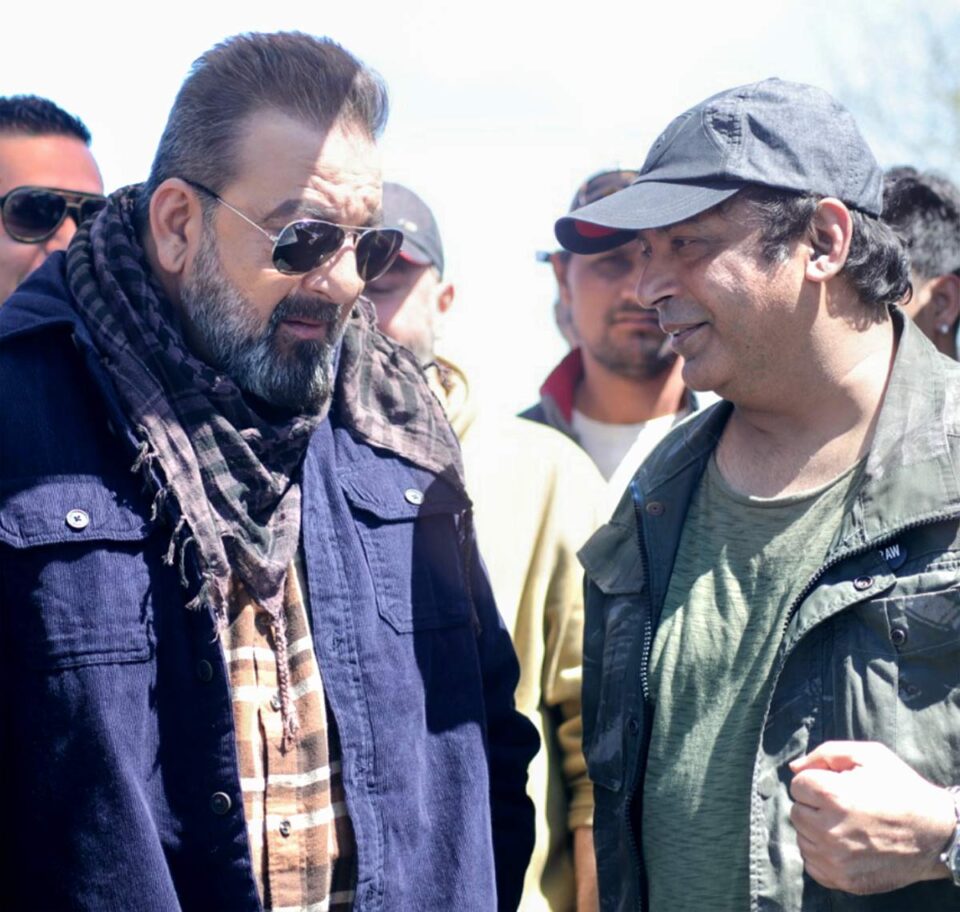‘I used to go to Sanjay Dutt, give him the scene, and then act it out.’
‘He would say, ‘Arrey, Girishbhai kar lunga‘.’
‘But I would insist: ‘Nahin, main karke dikhane chahta hoon‘.’
He said this was the first time in his career that someone was acting out the scene for him!’
IMAGE: Director Girish Malik with Sanjay Dutt on the sets of Torbaaz.
“There are enough stories in the world about hopelessness and humiliation. I wanted to come up with a positive story,” Girish Malik says.
And so, he brings us Torbaaz, starring Sanjay Dutt. It is a story set against terrorism, where a man tries to rehabilitate young children in refugee camps through the joys of cricket.
There were two actors in Malik’s mind, who would do justice to this character.
One, of course, was Dutt.
The other was his close friend, Irrfan Khan.
Irrfan and Girish worked together for six years on the popular television show, Banegi Apni Baat, in the 1990s.
Torbaaz is, Malik’s second feature film.
His first, Jal, may not ring a bell, but it was India’s entry for the Oscars in 2014, the year it released.
The film, starring Purab Kohli, Tannishtha Chatterjee and Rasika Duggal, won a National Award for Special Effects and won raves at the Busan International Film and the International Film Festival of India.
But such accolades didn’t make his journey easy in Bollywood.
“Some directors are very fortunate that an actor is just a phone call away. For others, it may take 20 years,” Girish Malik tells Ronjita Kulkarni/KhabriBaba.com.
How difficult was it to get Sanjay Dutt to act in your film?
Some directors are very fortunate that an actor is just a phone call away.
For others, it may take 20 years.
I have stories for every actor on this earth, including Brad Pitt.
I have a story for Aamir Khan too.
But how will I get to meet them and narrate my story?
Making my first film Jal was a very, very, tough journey, but things became easy when it won the National Award and got shortlisted for the Oscars.
I think actors need that kind of validation.
With the help of some common friends, it took me some 8-10 days to get to Sanjay Dutt.
I am very fortunate that I got a fine actor and the perfect face for my film.
I needed someone who had a lot of loss in his life and in his eyes, so that it would show in his character.
IMAGE: Sanjay Dutt in Torbaaz.
Was Sanjay Dutt your first choice?
I thought of two actors.
One was Sanjay Dutt.
The other actor was a dear friend of mine, with whom I had worked with in my television days: Irrfan Khan.
When I had told Irrfan the story, he had loved it.
But he told me himself that it is perfect for Sanjay Dutt.
What was it like working with Sanjay Dutt?
I used to go to him, give him the scene, and then act it out.
He would say, ‘Arrey, Girishbhai kar lunga.’
But I would insist: ‘Nahin, main karke dikhane chahta hoon.’
He said this was the first time in his career that someone was acting out the scene for him!
We had a very comfortable equation.
People had told me that shooting with Sanjay Dutt would be tough and problematic, but there was no trouble at all.
One fine day, he had come to me and said, ‘Paaji, I’m going to be 62, at least give me a one day break!’
We had been shooting nonstop for 12 days!
So I told him, ‘Please come tomorrow at 9 am and then I will give you a break for two days.’
The next day, he came at 7 am!
So I said ‘Don’t embarrass me, I will give you a break for two days.’
IMAGE: Sanjay Dutt in Torbaaz.
The film has been shot in Kyrgyzstan. What was that like?
We shot in almost minus 20 degrees temperatures.
There were high winds.
The weather was very unreliable — one day it would be snowing, the next day it would be sunny and the next, it would rain.
So we shot under all kinds of conditions.
No film has ever been shot in Central Asia.
There was no film infrastructure, so we had to create our own.
IMAGE: Sanjay Dutt and Nargis Fakhri on the sets of Torbaaz. Photograph: Kind courtesy Nargis Fakhri/Instagram
Your first film Jal was India’s pick for the Oscars. Did that help your career?
Nobody knew us, so it was a very tough journey.
The media in India and abroad were very kind to me and gave us great reviews.
But even then, it wasn’t easy.
It took me four-five years to make my next film.
Actually, post Jal, I expected a lot which was not right on my part.
I thought people would call me.
But people think either it is very art house or very commercial, they don’t want to think in terms of good story and bad story. So that was there as well.
So I decided to make two films — one with a star and one without. My second film is also ready now, and I am equally attached to both.
IMAGE: Girish Malik with Sanjay Dutt on the sets of Torbaaz. Photograph: Kind courtesy Sanjay Dutt Instagram
You started your career as an actor in Shola Aur Shabnam (1992).
Yes, I was 19 at the time.
I grew up in Delhi and was creatively inclined since childhood.
I explored many mediums.
I was a state level gymnast.
I was also a Chhau dancer, which is a semi-classical folk dance.
Then I got into Delhi theatre and that led to television.
I acted in two shows, Tara and Banegi Apni Baat.
Banegi Apni Baat ran for six years, and that’s when I worked with Irrfan Khan.
Later, I directed some episodes too.
I also acted in films like Krantiveer and Tiranga.
I was always interested in writing and direction.
I set up my own TV company when I was barely 27-28. I produced and directed more than 1,000 hours of TV shows, docu-dramas and ad films.
I created shows like Mission Fateh on the Indian Army, based on real life missions from 1947 to Kargil.
I was a successful TV actor and at the peak of my career, I felt I wanted to do something more.
I started travelling a lot. I went to Mexico, Brazil…
I started collaborating with studios worldwide.
I used to customise their content and bring a lot of formats to India.
Around 15 years ago, I decided to quit everything and concentrate on making films.
But that journey was very tough.
I was signed on to a lot of big studios, but the films would not take off.
I wanted to take things in my hands so I decided to start with a smaller film.
That’s how Jal happened.
IMAGE: A scene from Jal.
Jal released in 2014 while Torbaaz is releasing in 2020. How difficult was getting your second project?
It was very difficult.
I didn’t know which way to go.
You have a certain market and I could have continued on that path, where I would have made more world cinema.
But I realised that it is very important to do a film with big actors.
In India, that matters not only to the trade, but also to the public.
Now the trend is beginning to change with OTT. But until two years ago, it was very difficult.
If you were doing a film with a star, then you are a good film-maker. Otherwise, you are not.
You know, that one question that directors have to face: ‘Aapki picture main kaun hai?‘
So if you have taken newer actors, it comes out like an apology. You will say, ‘mera actor young hai, bada accha hai‘, but it sounds like an apology.
I want to make a big international film with a new cast.
I have a story set in Nepal, with Nepali actors. But I don’t know who is going to sign me for that.
Films haunt me in my head and I have to make them.
With Torbaaz, I got very lucky because I got both the right face and a star.
IMAGE: Sanjay Dutt in Torbaaz.
What hopes do you have from Torbaaz?
I have a lot of things on the pipeline, including two big films. I will be able to announce it in January or February.
One of them is with a big actor.
I would love to cast Ranbir Kapoor in a film.
I would love to work with Shah Rukh Khan, Aamir Khan and Akshay Kumar.
But that does not mean I will not work with new actors.
Today’s environment is such, thanks to the OTT, you can strike a balance and go with a big star cast as well as make an intriguing film with a new actor.
Are you okay with Torbaaz releasing on the OTT platform?
Who doesn’t want to have an inflated ego and watch his film on a big screen? (laughs)
I would have liked that.
Like, Jal was screened in a Busan theatre, which has the world record of having the largest screen in the world.
But there are pros and cons.
In theatres, it releases for a week or two and then comes on television or OTT.
But on Netflix, the film will go to 192 countries, and in different languages. So I didn’t mind it.
At the end of the day, I want my films to reach a global audience.




